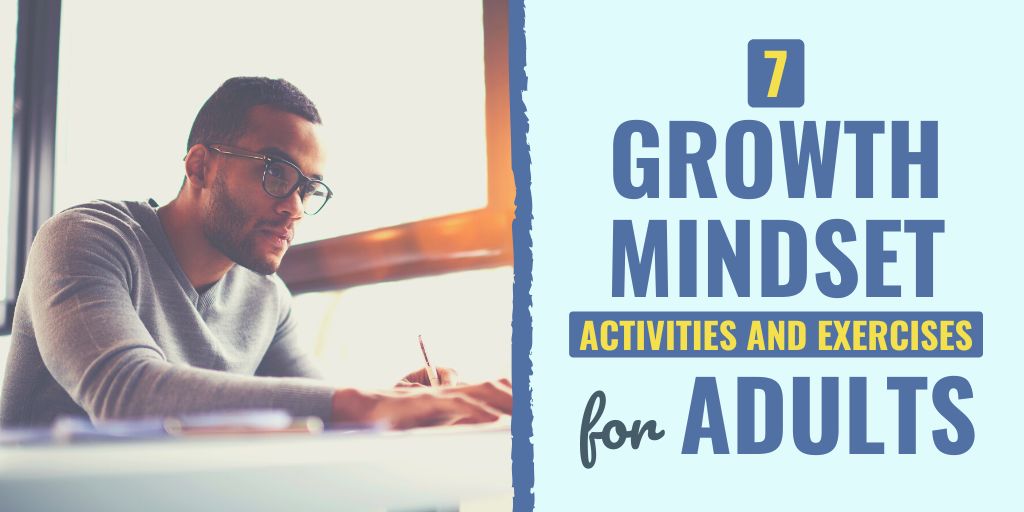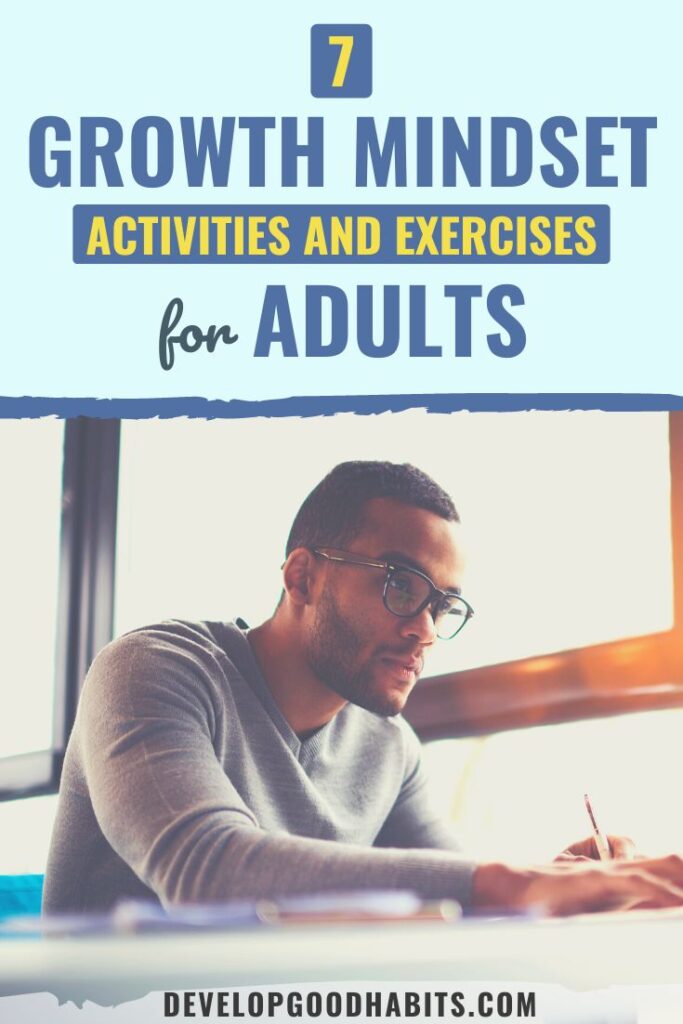There might be affiliate links on this page, which means we get a small commission of anything you buy. As an Amazon Associate we earn from qualifying purchases. Please do your own research before making any online purchase.
Do you get frustrated when you make a mistake? Or when you’re faced with a challenge, do you give up because you assume that you can’t do it?
These are two reactions that someone with a fixed mindset would have. People with a fixed mindset believe that they’re born with their skills and those skills can’t be changed. However, there is a big difference between people with a fixed mindset and people with a growth mindset.
Carol Dweck’s research has shown us that having a growth mindset enables you to believe that you’re in control of your skills, meaning you can learn and develop new skills and improve them throughout your life. Your abilities are something you can grow over time–like a muscle.
The Importance of Growth Mindset Activities
Think about it, in order to build your muscles, you have to challenge them by adding weights to create a struggle–but this is a productive struggle. This is the same principle that applies to learning new things. You need to challenge your brain in order for it to grow.
Now, if you have a fixed mindset, you may take this idea by going to the gym just one time, lifting weights, and noticing that there’s no change to your body when you’re done. But building both your muscles and your brain takes time and repeated practice.
Here’s another thing to think about: You also can’t go to the gym and watch someone else lift weights and then get stronger yourself. You have to actually take action and practice. Again, this same principle applies to learning.
These two mindsets have a huge impact on your ability to achieve your goals.
When you’re facing a challenge with a growth mindset, you see it as an opportunity to build upon your abilities–making you more optimistic and more likely to seek out challenges for the purpose of improving yourself.
Teachers are now being instructed on the difference between these two mindsets to help their students cultivate a growth mindset. But seeing as Carol Dweck’s research is relatively new and has only gained attention in the past 15 years, there are a lot of us who are now adults who were not taught as children to have a growth mindset.
So, how do you change your ways and develop a growth mindset as an adult?
In this article, I will illustrate 7 growth mindset activities for adults that you can do to help revamp your way of thinking to help you get excited about the challenges that you face and achieve success in a way that you never before believed that you could.
Let’s get to it!
7 Exercises and Activities to Help Adults Develop Growth Mindset
1. Start
When you have a fixed mindset, you probably won’t even start trying to learn something new. Why try if you weren’t born with the ability? And if you do start, you likely won’t stick with it if it seems challenging because the task at hand is simply not a skill that you have.
The first growth mindset activity you need to do is to take that critical first step. And, this isn’t just making moves toward things that you are passionate about or really want to know how to do.
Part of this is getting out there and trying new things so you can uncover your passions and truly find out what’s right for you. You have to locate your untapped potential. You may already know what fascinates you, but if you don’t know everything that is out there, you’re strongly limiting yourself.
Once you start learning something new, compete with the person you were last week. Continue to have this competition with yourself to keep growing and improving from where you were at the very start.
And it’s ok to start small–it’s even important to do so when you’re trying to learn something new. You have to get out of your head, which just requires dipping in your toes.
To better understand this concept, here are some growth mindset examples that can help change your beliefs. You can also take one of these growth mindset quizzes to get a general idea on what your current mindset is.
2. Reflect
Think about all of the skills that you have built throughout your life and how you have advanced them. No matter what you’re mindset is, surely you can think of something that you were not good at doing when you started it, but you eventually got the hang of it.
For example, think about your first day at your current job.
Did you show up having the routine and work flow that you have today?
Or did you have to go through some trial and error in order to learn how to be good at what you do?
You probably had to “practice” your job by showing up each day and facing various problems that you had to work to solve.
Think about what this process was like–whether it is your current job or something more basic such as driving a car or learning how to cook a simple meal.
Reflecting and recognizing the skills that you have improved throughout your life will help you be more open to the idea that you can learn and improve.
Once you do start to learn a new skill, reflect on your progress and what you have learned up to this point and keep a record of how that progress continues to change.
3. Do a Bit of Research
Let’s talk about neuroplasticity. Neuroplasticity is the study of the human brain and how it adapts to various environments and changes as humans take new actions or experience new things.
Historically, the brain was thought to be a “nonrenewable” organ–in contrast to other parts of our body, such as our skin that can heal after being cut or our blood which can rebuild if it’s lost.
It was once believed that the brain could not generate new neurons because the majority of the brain lacks the stem cells that are needed for regeneration.
However, this idea was challenged throughout the years in various studies in adult mammals, and it’s now widely accepted that the brain can grow, regenerate, and change, which has an impact on our cognitive functioning.
Many subsequent studies focused on the use of antidepressant medications and their ability to restore normal neurogenesis that had been damaged by stress. These studies further proved the brain’s ability to regenerate itself.

The basic facts of how the brain works show how it can grow and learn new things, regardless of one’s age. Your brain contains an abundance of circuits and pathways, and whenever you do a task, you’re firing a pathway in your brain.
If you repeatedly fire the same pathway, your brain will build up that circuit and improve your ability to perform that task–meaning that practice will build a skill.
And, not only can the outer layers of the brain be changed as an adult, the deepest structures of the brain–including the brain stem–can also change. This has been seen in studies that looked at brain scans of illiterate adults both before and after teaching them to read.
Knowing about neuroplasticity will allow you to recognize that your brain’s capacity to grow is much greater than you probably thought. It will help you see that your brain is physically capable of growing, and therefore, your skillset is capable of growing as well.
4. Seek Out Learning Opportunities
Specifically, seek out a learning opportunity that you think you’re “not cut out” for.
Take dancing for example. Do you believe that you simply lack the coordination or the creativity to be a good dancer and therefore tend to avoid the dance floor at all costs? Maybe you just “don’t have rhythm”.
If this is the case, I would challenge you to learn this skill by taking a dance class. Get out of your comfort zone. And don’t just go for two or three classes and then quit because you don’t feel like you’re making progress.
If you want to learn how to dance, stick with the class, get comfortable with being uncomfortable, and learn to approach dancing with a “can do” attitude.
You will find that by the time the class is over, not only will you have learned some basic principles of dancing, but you will have successfully executed dance moves that you have never done before.
Will you be a professional dancer? No. But you will be one step closer to being a good dancer and you may already develop that confidence to dance in front of others. The more you practice, the more natural it will come.
No matter what you seek out to learn, create some SMART goals. This will allow you to have a specific target to work toward and let you watch your progress as you go.
Using the dancing example, rather than saying I want to be a better dancer, say I want to confidently dance on the dance floor at my cousin’s wedding this summer. This gives you a concrete goal with a deadline that you will either accomplish or you won’t.
Another way to be sure to meet your goals is to make an “If-Then” plan, which will help you create mini-goals to help reduce your chances of having a setback.
In the process of learning, visualize what it will be like to reach your ultimate goal in order to keep you motivated to continue practicing. Also, consider some obstacles that you may face along the way and make a plan to overcome them.
For example, there will probably be someone in your dance class who is more skilled at dancing and you might think this could intimidate and discourage you from wanting to continue taking the class.
In this case, you have to think about this hurdle from a different perspective. Maybe that person started exactly where you are now just a few years ago and they’ve now gained the skills that you could gain by practicing.
Whatever learning opportunity you seek out, stick with it.
5. Cultivate Grit
Angela Duckworth, who won the MacArthur “Genius” Award for her research on grit, has put this word in the forefront of successful people’s minds since 2013.
Your grit defines your perseverance to meet your goals. It is the amount of effort you are willing to put forth to accomplish something and your willingness to keep moving–no matter how difficult things get–when the reward is far away. In order to have a growth mindset, you have to cultivate grit.
To develop grit, you must find something that you’re interested in learning and do anything it takes to improve that skill every day. You also have to believe it’s possible to make progress, greatly improve, and succeed–as long as you’re putting in the necessary work.
Finally, you have to surround yourself with others who have grit. Identify people who stick to their goals without allowing themselves to get distracted. Who do you know who continues to show up, even when things get really challenging?

The people you surround yourself with have a big impact on your behaviors and beliefs, so when you spend time with people who have grit, their norms and standards will influence you and you will develop grit as well. This positive form of peer pressure will teach you by example how to cultivate grit.
Another way to cultivate grit is to be willing to be flexible in your thinking patterns. When you’re rigid in your beliefs, you view problems as being hurdles.
However, if you can lighten up, you will welcome obstacles with enthusiasm because you’ll view them as a chance to grow. You’ll use new and creative thinking strategies to solve problems and have the confidence to plow through any obstacles that you face.
A final element to cultivating grit is knowing your purpose and finding the meaning in what you do. When you’re aware of the greater meaning of your work, you can see how it’s important to other people–not just to yourself.
Knowing that your work matters to others is what creates your sense of passion, and makes your perseverance for it sustainable.
While this doesn’t make your work easy, it does make it satisfying because you’ve chosen to continuously be challenged–and with a growth mindset, you will be confident in your ability to overcome those challenges.
6. Keep a Journal for 21 Days
This activity will challenge you to start trying new things every day for 21 days. The activity could be something that you have seen your friends do but you have never tried or something that you’ve never thought of doing before.
As long as it challenges you and steers you out of your comfort zone, this growth mindset activity will be effective.
For the first seven days, you’ll probably stick to things that are sort of familiar and not too unusual. However, the challenge will get more difficult in the second week because you’ll need to get a bit more creative with the things you’re trying.
During the third week, you’ll have to get even more innovative with your actions, which will force you to do a few things that you’re completely unfamiliar with.
By the end of the three weeks, you will discover some new abilities and unrealized potential that you were previously oblivious to. By regularly disrupting your routine, you will notice a shift in how you perceive your everyday potential and possibilities.
The cumulative impact of doing new things each day can be transformative and result in an increased sense of wellbeing and confidence as you will see all of the new information that you can (at least start to) learn.
Here are some growth mindset journal prompts and growth mindset statements that can help you get started.
7. Try New Learning Strategies
Adults and children learn very differently from each other. Children are starting with a blank slate, and therefore gaining new knowledge from everything that they experience.
Children have no barriers to learning because everything is new and their main focus in both work and play is to make sense of their surroundings. (These growth mindset coloring pages are a great way to start teaching kids about growth mindset.)
However, over time, the things that we learn actually become a barrier to new learning. Once we believe we have figured something out, we stop speculating.
This means it can be more of a challenge for adults to learn new things, but it is certainly not impossible. Adults just need to use new strategies to learn that they didn’t use as children.
First, adults needs to self-direct their learning, meaning they do it at their own pace and they learn what they want to learn. They also have to take the time to reflect on what they’re learning and use a reasoning process to make meaning of the information. The information must be analyzed to be understood.
Watch the video below to explore 10 of the most powerful mind tricks you can use to learn anything fast.
Adults also have to be able to have a relevant experience to help retain what they’re learning. Remember when we said that the brain is like a muscle and you can’t watch someone else lift weights and expect to get stronger yourself?
This is the same concept in that adults have to do instead of just watch or listen. So while audio and visual learning are still important, adults must engage in tactile learning as well.
Finally, adults need to be working toward a goal or have a purpose for learning. Adults don’t seek to learn just for the sake of it–there needs to be a light at the end of the tunnel. All of this means that adults need to figure out how to learn as adults to maintain a growth mindset and believe learning is possible.
Final Thoughts on Growth Mindset Activities for Adults
When you’re doing growth mindset activities for adults, remember to start small and stay patient. You will notice that you will gain momentum once you begin to see progress.
After reaching your goal of learning whatever skill you’re focusing on and you feel proficient, don’t stop trying to improve, because this will cause your growth to plateau. Instead, continue to challenge yourself with it–aim to become an expert.
If you're still aren't clear on the difference between the two, here's our video on the different of examples of fixed mindset vs. growth mindset.
I challenge you to engage in these growth mindset activities for adults to help get rid of your fixed mindset and put yourself on a new path to success.
In our rapidly-evolving society, it is imperative that you don’t succumb to the belief that you have reached your limits. You have to deliberately work to improve yourself in order to keep up with those around you.
And if you're looking for more resources to develop your growth mindset, be sure to check out these posts:
- 10 Growth Mindset Goals Examples to Change Your Thinking
- 27 Growth Mindset Examples to Change Your Beliefs
- 9 Growth Mindset Worksheets and Templates
Finally, if you want to take your goal-setting efforts to the next level, check out this FREE printable worksheet and a step-by-step process that will help you set effective SMART goals.

Connie Stemmle is a professional editor, freelance writer and ghostwriter. She holds a BS in Marketing and a Master’s Degree in Social Work. When she is not writing, Connie is either spending time with her 4-year-old daughter, running, or making efforts in her community to promote social justice.


